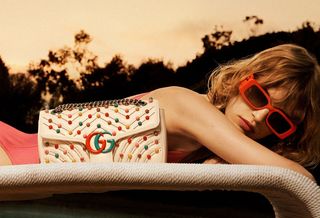It is that time of the year when I turn into a fish. With temperatures in Mumbai, where I live, touching 40 degrees, and the city’s famous clammy humidity slapping you in the face, the only way to survive is underwater.
I’m lucky I love to swim. I’m luckier because I love to tan.
This May’s sun-bathing has turned me into a warm toast, and I am not even done yet. There are two more weeks of a heatwave to go, and until our famous monsoon arrives, the swimming pool is where you will find me.
I fail to fathom why tanning goes out of fashion. Everything looks better on you when you are golden. Gucci has rebranded itself post Alessandro Michele and dived into its classical styles. Their new campaign, Summer Stories, is shot in the swimming pool and on a beach with oodles of swim and summer wear (stripes, florals, and their vintage GG motif), all worn by tanned bodies.
It is a myth that tanned skin is coveted by Caucasians while brown-skinned folks like us are loath to get darker. Tanning has been historically looked down upon across cultures. The west associated sun-tanned faces with lower class field workers. Pale pasty skin was considered delicate and upper class. Rich women ensured their clothing protected them from the sun, with hats, parasols and gorgeous scarves. In India, young girls are routinely asked by their families not to play in the sun for fear of getting dark. ‘Fair & Lovely’ was our best-selling beauty product, until cultural pressure rechristened it to ‘Glow & Lovely’, only very recently.
By the early 20th century, Vitamin D deficiency began to be recognised as a cause for rickets, and the therapeutic benefits of sunlight were beginning to be highlighted by doctors, especially Niels Finsen, who won the Nobel in medicine for his “light therapy”.
But it wasn’t until Coco Chanel that suntans became chic. Chanel’s toasty cheeks, thanks to an accidental sunburn while on holiday, found many fans, and European ladies began emulating her. The American-born French singer, actress and civil rights activist Josephine Baker was another icon who the stylish women of France had begun to ape.
Soon enough, tanning oils were introduced in France. And by 1946, once the bikini was invented, swimsuits were as little as they could possibly get. Tanning was popular for decades after that, especially in the 1960s. By the 21st century, exposure to the sun’s ultraviolet rays began to be considered dangerous and a cause for skin cancer. Tanning beds were proved to increase the risk of melanoma and were banned in sun-loving countries like Australia, Brazil and some parts of the US.
But tanning seems to be throwing shade at all that. It is coming back and claiming its spot in the sun. New tanning oil labels like Dolce Glow and Tan-luxe are offering themselves as the safest alternatives. Miley Cyrus is an investor in Dolce Glow, lending much celebrity sparkle to the company. Hailey Bieber promoted Tan-luxe on TikTok, and Jennifer Lopez spray-tanned herself for the Met Gala.
The self-tanning (or sun-tanning with protective oils) industry grew by 70 per cent in the US between 2017 and 2022 (and reached $304 million in sales last year), according to Euromonitor. In India, the rich prefer to tan to look like they have returned from a summer vacay or a golf holiday. For the rest, there are just one or two self-tanning oils in the market, but more than a dozen ‘de-tanners’.


